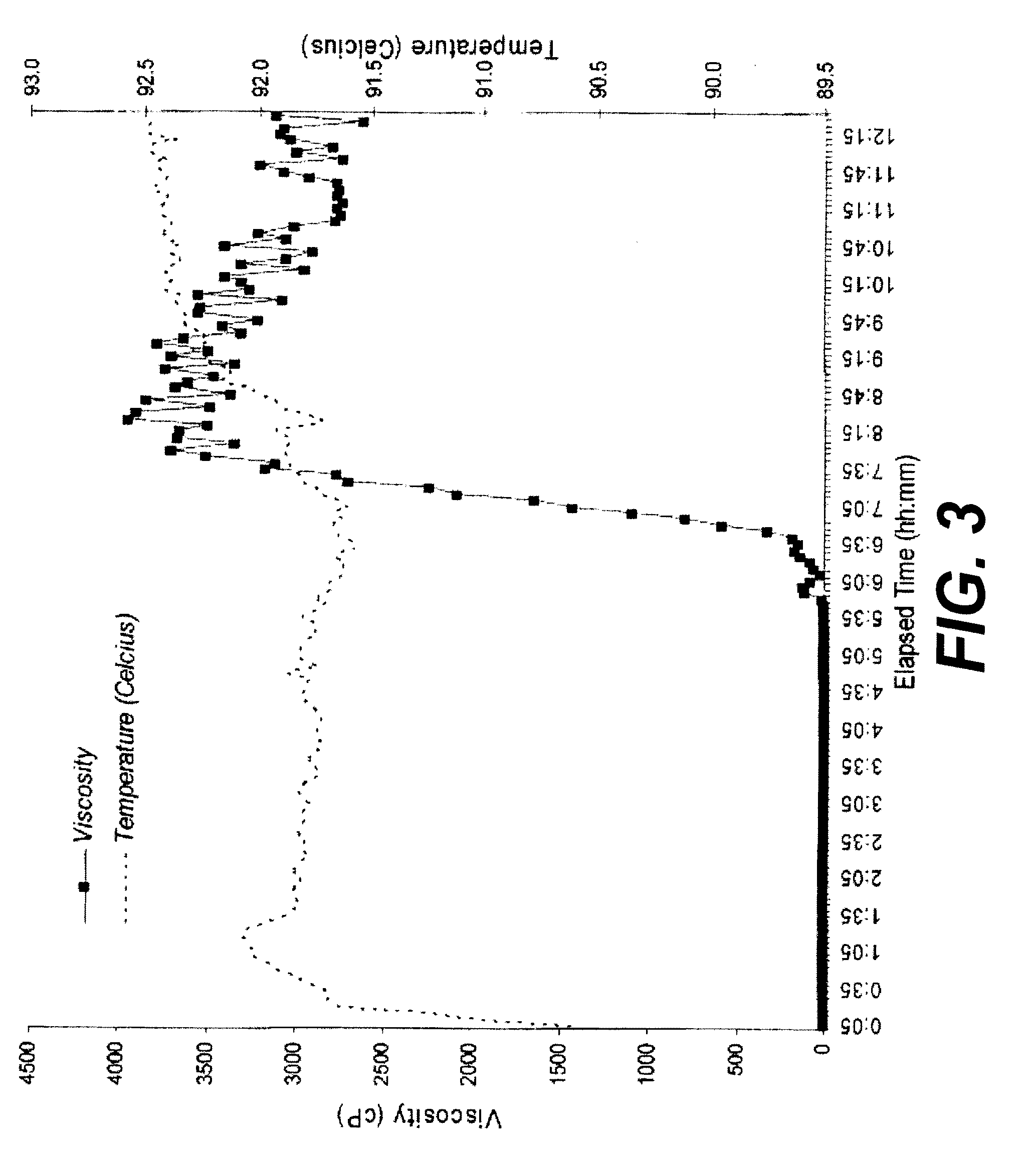Methods of using colloidal silica based gels
a technology of colloidal silica and gels, which is applied in the direction of sealing/packing, chemistry apparatus and processes, and well accessories, etc., can solve the problems of insufficient gels, reduced hydrocarbon overall yield, and inability to meet the needs of subterranean use in some areas, and achieves the effect of increasing the viscosity of treatment fluids
- Summary
- Abstract
- Description
- Claims
- Application Information
AI Technical Summary
Benefits of technology
Problems solved by technology
Method used
Image
Examples
example 1
[0045]To determine the effect of temperature and activator concentration on the time required for a mixture of a colloidal silica component and an activator to reach a given viscosity, a base treatment fluid was prepared which comprised an aqueous colloidal silica component. At room temperature, the base treatment fluid had an API plastic viscosity of 7.5 centiPoise (cP) and an API yield point of 1.8 lb / 100 ft2 (0.0879 kg / m2). A potassium chloride activator was added to individual portions of the base treatment fluid in varying amounts to create experimental samples that contained the colloidal silica component and activator in varying relative amounts. The experimental samples were cured at 22° C., 50° C., 70° C., and 80° C., respectively. The gel strength of each sample was measured over time using an apparatus known as the Mini Multiple Analysis Cement Slurry (“MINI MACS™”) analyzer until the gel strength reached a final value of 500 lbs / 100 ft2 (24.41 kg / m2). The MINI MACS™ anal...
example 2
[0046]To demonstrate the ability of a colloidal silica gel to mitigate the migration of a fluid and / or gas through a cement slurry, the gel strength development of a typical cement slurry was tested at conditions typical for a surface casing in a field where pressurized shallow water zones present a drilling hazard. One design parameter commonly used by the industry when dealing with gas migration and shallow water flow is the time it takes for the static gel strength (SGS) of a slurry to increase from 100 to 500 lbs / 100 ft2 (4.88 to 24.41 kg / m2). This time is often referred to as the “transition time.” Ideally this time should be as short as possible in order to minimize the time that gas or fluid can migrate into the cement matrix after placement. The cement slurry that was used in this test comprised a class C cement, the colloidal silica commercially available under the trade name FDP-C725-04, a potassium chloride activator, and other cementing chemicals such as a fluid loss con...
example 3
[0047]In order to determine if the pore space of a typical formation might be blocked by a treatment fluid of the present invention, such that the pore space was substantially impermeable after treatment, the following experiment was performed. In addition, this test was designed to determine whether viscosified treatment fluids of the present invention might be able to withstand pressures of the type that may be encountered across a formation core having high permeability. Bentheim sandstone core was selected for this experiment due to the relatively high permeability of this type of core. The Bentheim sandstone core that was used was substantially clay free, homogeneous, and had a porosity of about 22%. The core measured 3.70 cm in diameter, 5.78 cm in length, and had a permeability of 846 milliDarcies. The pore volume of the cores was determined to be 13.67 mL.
[0048]After the core was mounted in a Hassler cell core holder and vacuumed, the core was placed in a vertical orientatio...
PUM
| Property | Measurement | Unit |
|---|---|---|
| temperatures | aaaaa | aaaaa |
| diameter | aaaaa | aaaaa |
| particle size | aaaaa | aaaaa |
Abstract
Description
Claims
Application Information
 Login to View More
Login to View More - R&D
- Intellectual Property
- Life Sciences
- Materials
- Tech Scout
- Unparalleled Data Quality
- Higher Quality Content
- 60% Fewer Hallucinations
Browse by: Latest US Patents, China's latest patents, Technical Efficacy Thesaurus, Application Domain, Technology Topic, Popular Technical Reports.
© 2025 PatSnap. All rights reserved.Legal|Privacy policy|Modern Slavery Act Transparency Statement|Sitemap|About US| Contact US: help@patsnap.com



